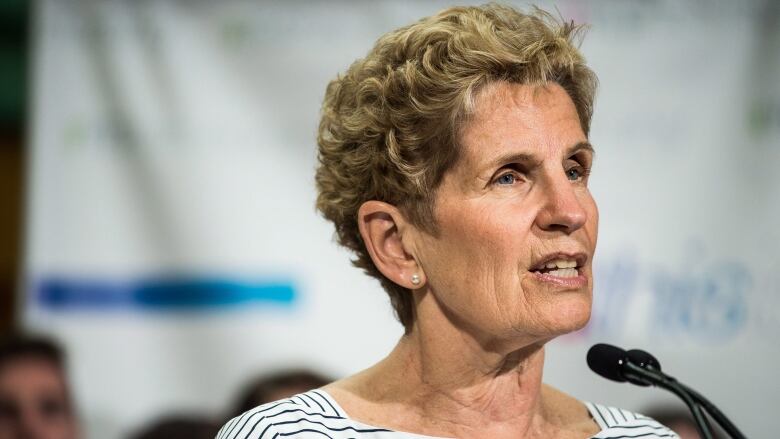Wynne is offering solutions to health care problems her government created
Three years ago, her government cut residency spots. Now she's promising cash to fund new ones

I graduated from medical school the same week that Kathleen Wynne was elected premier in 2014. So it has been under her tenure that I have spent the last four years as a frontline physician trainee, witnessing firsthand the dysfunction with which health care delivery operates in this province.
The majority of our challenges are due to a combination of government inaction and a willful go-it-alone philosophy. The growing need for mental health services has been addressed at a glacial pace, for example, while Bill 41,the Patients First Act the most significant alteration to health care delivery in recent memory was passed despite significant opposition fromhealth care leaders across the province. This could not have been worse for patient care.
Our increasing shortages in primary care, along with unacceptable wait times for specialist care, will surely come to characterize this government's legacy. And as Ontario's population grows in size and age, our health care utilization, by definition, will swell. This means more patients using our health care system with increasing frequency.
-
Ontario to fund more residency positions for graduating doctors
-
ARCHIVE:Ontario cuts 50 medical residency places, critics warn of doctor shortage
However, not only has the provincial government appeared unconcerned with this issue until now, it has actually made things worse. Three years ago, for example, it made the baffling decision to cut the number of residency spots in the province, thereby reducing the number of newly trained physicians. There have also been deleterious changes to the delivery structure of primary care under Wynne. This includes barring new family doctors from entering capitation models such as family health teams and family health organizations (except in certain rural communities), thereby eliminating incentives for these graduates to start new practices.
These decisions have helped contribute to the fact that 800,000 Ontarians now find themselves without a family doctor. That means many of them access costly medical services through emergency rooms, which only adds to chronic hospital overcapacity, known as code gridlock.
The government is also responsible for creating labyrinthine bureaucracies that have made a mess of home and long-term care. At last count, there were more health care bureaucrats than family doctors in Ontario.
Cleaning up mistakes
Now that the provincial election is underway, the Wynne government has promised to fix all of this. It has, for example, recently announced funding for 53 new medical residency spots a solution to a problem that they themselves created. The Liberal government also created a group of administrative organizations known as "local health integration networks" that cost nearly $70 million annually to operate, despite being criticized as a waste of money that does not significantly improve care. This seems to be its modus operandi.
Ontario has the distinction of having one of the fewesthospital beds per capita compared to other OECD nations. In response to these and other conditions, physicians across the province sprung into action: this year, the Ontario Medical Association unveiled a platform entitled "Not a Second Longer," calling for government action on unacceptable wait times, while the Concerned Ontario Doctors launched "Care not Cuts" years ago focusing on "the government's neglect and mismanagement of healthcare."

That is why, when the premier stood at a lectern at Sick Kids Hospital last week, her hubris and slogan "care over cuts," which Wynne is using to distinguish her platform from that of PC leader Doug Ford cut deeply. Not only did she co-opt physician advocacy efforts almost verbatim for personal political gain, she did so in front of a Canadian health care institution that she has so badly underfunded, it is resorting toprivate donations for help. While that might be the norm, it shouldn't have to be.
Let's be clear. No party has yet to articulate a clear, comprehensive and effective strategy to fix health care. And they all shoulder the blame for the implementation of myopic strategies during their respective governments. Of course, in the spirit of buying votes, all have now pledged more funding dollars, which is, at the very least, the bare minimum required.
What is not being offered to voters is a fresh, new take on health care reform. Advisers to current and previous governments continue to dictate worn health care policy, despite decades of poor performance, devoid of innovative and diverse thought. This stagnation is emblematic of the past 15 years.
Ontarians, it seems, have had enough. The public is unhappy with how they and their loved ones are cared for. And we can't blame them. Physicians, too, are similarly fed up with a government that makes our job of caring for patients even harder. We need realleadership focused on working with doctors and other health care providers to create meaningful and sustainable change.
This column is part of CBC'sOpinion section. For more information about this section, please read thiseditor'sblogandour FAQ.












_(720p).jpg)


 OFFICIAL HD MUSIC VIDEO.jpg)
.jpg)



























































































